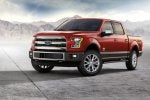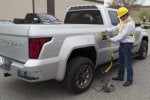
Today mainstream-priced plug-in hybrids are mostly compact and midsized front-wheel-drive cars while Americans are shifting toward larger cars, AWD trucks, and SUVs.
Do you see a disconnect in this picture? Are automakers’ out of touch with what people would snap up in a heartbeat if only they were made available?
Is the goal in electrifying vehicles to slash petroleum consumption, or to do only enough to barely nurse along a 0.5 percent market share of content-rich and commensurately priced vehicles guaranteed to sell in limited quantities?
While some have wondered whether a conspiracy is in play, realities are what they are at this juncture, but in the interim we’ve come up with a fantasy wish list of vehicles we think could be a hit if done and priced right.

Aside from the Chrysler Pacifica Hybrid 7-passenger plug-in hybrid, which with incentives is priced competitively with its non-electrified siblings, the few plug-in SUVs and AWD crossovers sold in the U.S. now are upscale.
As for what’s motivating automakers to only offer what they do, a plethora of variables are responsible but primarily plug-ins are being spliced into product lines to increase national fleet average mpg and CO2 scores, or to specifically comply with California regulations.
Plug-ins cost more to make and purchase, take special marketing and sales efforts, require new owner behaviors, and automakers – comfortable selling products people want in a time when gas prices erode plug-ins’ competitive edge - are doing mainly what they have to.
More plug-ins will be coming to meet tightening regulations, and increasing consumer demand, but meanwhile the goal of our list is to dream up feasible vehicles that could better meet the spirit of the law, not just the letter of the law.

That is, the intent behind regulations demanding cleaner cars is to cut petroleum consumption and emissions on a significant scale, and that will mean mass volumes.
In brief, big sales come from popular products. Popular products are those that give people what they want at a price they can afford. Never mind that Tesla’s Elon Musk has said automakers have an inherent conflict of interest in selling perceptibly superior electrified vehicles alongside their bread and butter lines, we’re just dreaming here.
And really, our list is only low-hanging fruit: all that would be required to make them so is to revise an existing vehicle to PHEV status. Ideally, as we’ve seen being done already, purpose-built plug-ins are desirable over converted conventional or hybrid vehicles as they are better able to package enough batteries for longer EV range without compromising cargo or passenger space.

That said, several plug-in hybrids already are converted from hybrid models, so we’re just expanding on that formula. The technology for more exists, but to date the will has not. It’s believed some of these vehicles will in time be built, but meanwhile, here are some ideas for plug-ins that could be welcome now.
Toyota RAV4 Prime
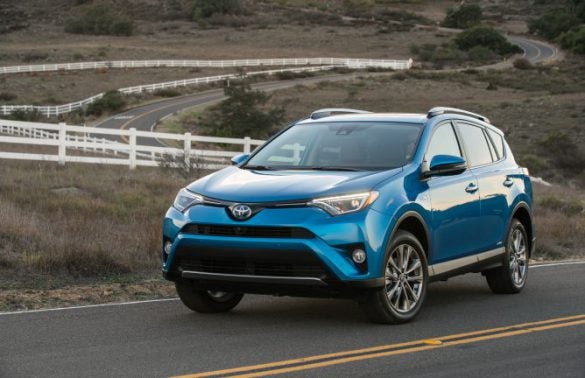
Introduced last year, the RAV4 Hybrid is an all-wheel drive SUV based on the popular and just updated conventional model, and it would be ideal to make into a plug-in hybrid.
If made into one, its name could just as well be the RAV4 Prime to stay consistent with the Prius Prime plug-in hybrid which is called "Prime" to help distinguish it as the range topper.
Since the RAV4 Hybrid's dealer launch, Toyota has been selling these in greater numbers than its Prius v and Prius c and Camry Hybrid which formerly were sales chart leaders.
The RAV 4’s engine is the same as in the Lexus NX hybrid and delivers 112 horsepower at 5,700 rpm, 206 pounds-feet torque at 4,100. The electric motor contributes 141 horsepower (105 kilowatts) at 4,500 rpm in front, 199 pounds feet torque, and the independent rear motor can supply 67 horsepower (50 kilowatts) at 4,600 rpm.
Total system output is 194 horsepower, comparing favorably with 176 horsepower for the gas-only RAV4.
Toyota's electric AWD is a system that could be adopted by other enterprising automakers. Called AWD-i, it senses slippage and comes on as needed to augment traction. It’s found on other Toyota crossovers such as the Toyota NX and Lexus RX.
Stuffing in a 10-14 kWh battery might yield electric range in the 20s, possibly lower 30s while retaining its 34 mpg city and 31 mpg highway economy in hybrid mode – or possibly improving it. Toyota did that with the Prius Prime over the 52 mpg Liftback hybrid by letting it rely more heavily on its bigger battery in hybrid operation, and yielding 54 mpg.
Toyota has not indicated it would build a RAV4 Prime, but if it did, and could price it as aggressively as it does the Prius Prime. Though the ostensible top of the line, it's priced midway in the Prius hybrid lineup. Similarly, the two RAV4 Hybrid trims are only $700 over the conventional similarly (well) equipped RAV4s. Toyota knows how to sharpen its pencil when it wants to, and a RAV4 Prime could be another model to benefit from that policy.
Honda CR-V Plug-in Hybrid
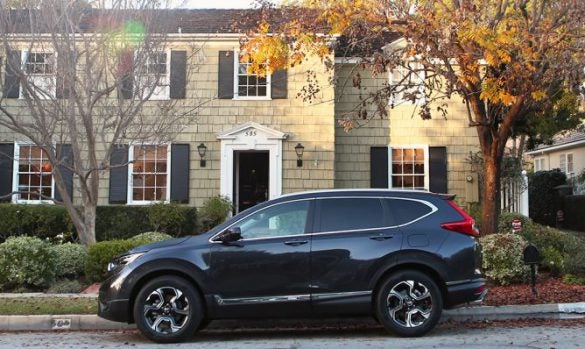
Honda actually just introduced a CR-V Hybrid in China , odds are good it will eventually make its way to the U.S., and while it is at it, a plug-in version would be welcome.
The CR-V Hybrid uses a version of the dual-motor hybrid system found in the Accord which happens to be the most-efficient midsized hybrid sedan sold at 48 mpg combined.
You might notice however that tall, all-wheel-drive crossovers when hybridized do not tend to do as well over conventional stablemates as hybridized sedans. The Accord gets an 18 mpg (60 percent) improvement over a the most-efficient non-hybrid Accord, and a Camry Hybrid with the same basic powertrain as the RAV4 Hybrid gets a 13 mpg (48 percent) increase over a non-hybrid Camry. The RAV4 Hybrid however is only 6 mpg (23 percent) better than the conventional RAV4 , and similarly, a Nissan Rogue Hybrid is only 6 mpg better.
So, how many mpg in hybrid mode and how many miles range in EV model a theoretical CR-V PHEV might get is an open question, but it could be in the upper 30 mpg region, and electric range – a function of battery size – might also be in the 20s or 30s.
Power otherwise could be good if the Accord’s 2.0-liter engine were used which combined with a 181 horsepower (135 kilowatts – traction motor) and 142 horsepower (106 kilowatts – generator motor) yields a class-leading 212 system horsepower.
As with all these hypothetical vehicles, pricing would make or break it, and it is likely early but not out of the question for such a vehicle. To date, Honda has been one to max out content for its hybrid and plug-in vehicles making them have limited appeal compared to conventional alternatives.
Otherwise, Honda’s plans are for two-thirds of its global automobile lines to be electrified by 2030 so it will need to get there somehow. It is introducing its plug-in Clarity sedan from the mid $30,000s this year – which also comes in a battery electric and fuel cell version – and to increase sales, Honda knows price for performance will need to come down.
Nissan Rogue Plug-in Hybrid
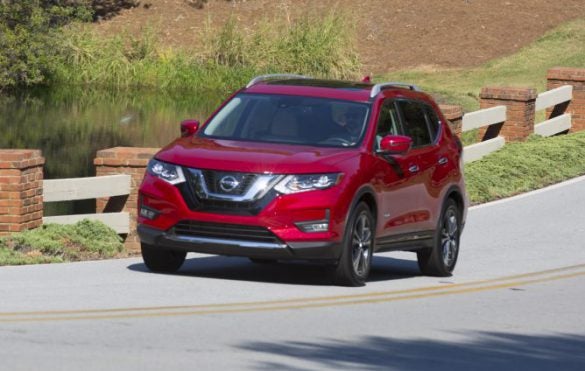
Here too, Nissan is already on its way as a Rogue Hybrid does exist, so this is another case of just add batteries.
Not so incidentally, the “problem” with adding batteries, aside from cost, is packaging.
Namely, if simply stuffed unceremoniously in the trunk, room is decreased for cargo, and if the seats don’t fold down, that also takes away from a vehicle meant to be haul stuff.
Assuming Nissan – and others in this list (and while we’re at it, add in a Ford Escape PHEV and Chevy Equinox PHEV as they all follow a similar formula) – can find space to put the batteries, it could create another vehicle to make people clamor less for the elusive Mitsubishi Outlander PHEV.

The existing Rogue Hybrid meanwhile combines a 2.0-liter four-cylinder gasoline engine producing 141 horsepower with a 40 horsepower electric motor that’s powered by a lithium-ion battery. The one-motor/two-clutch design has a total system output of 176 horsepower.
AWD models are estimated at 25 mpg city, 32 highway, 28 combined. This could be retained with PHEV mode, and 20-30 or so miles EV range could mean a part-time EV.
Nissan priced the Rogue to go head to head with Toyota’s new hit, the RAV4 Hybrid. Nissan has otherwise said it has advanced batteries for its other plug-ins, including the new pending Leaf EV, its pricing for these critical components is likely competitive, and it so it could be competitive with a Rogue PHEV.
As with the rest of these, there has been no announcement that such a vehicle is in the works, but for you in the snow belt, would you be open to it if it were?
Toyota Sienna/Honda Odyssey Plug-in Hybrids

These maxi-sized “minivans” are the quintessential “family haulers,” and while Honda and Toyota have been serving up outstanding hybrid minivans in their home market for years, they’ve never been motivated to bring them stateside.
With the introduction of the Chrysler Pacifica Hybrid, can you think of a better time than now for the Japanese automakers to stop holding out on the North American market?
The benchmark to beat is actually quite competitive: Chrysler’s 7-passenger plug-in hybrid has an outstanding EPA rating of 33 miles range form its respectably sized 16-kWh battery hidden beneath the floor so as to minimize space compromises. It also gets a great 32 mpg in hybrid mode which is in line with some compact cars.

This involves V6 power so it has what it takes if you decide to take your spouse and you five children on vacation across country in a loaded-up vehicle.
To date the Chrysler is the only such vehicle in its class, it is by far the most efficient over the present Honda Odyssey and Toyota Sienna which get low 20s mpg, but those automakers could easily engineer their own versions if they wanted.
Of the two, Toyota has been less gung-ho about plug-ins – the Prius Prime is its only one, and it's still working toward the Japanese vision of a “Hydrogen Society.” Honda actually is on board with fuel cell vehicles as well, but it’s been more open to plug-ins, and both are open to regular hybrids.
Imagine if they had a change of heart. Regulations have a way of doing that, and so does competition, and now they have both.
Ford F-150 Plug-in Hybrid

America’s best-selling truck simply has to be made into a plug-in hybrid, and it may only be a matter of when.
It’s not that we’re biased toward Ford, and we’ll note plug-in hybrid versions of GM and FCA and Japanese pickups would be great too, but Ford has said the most to date that such an animal could see the light of day.
For starters, Ford has said a hybrid version is in the works for by 2020, and a plug-in version might have been spied road testing as well.
This was last spring, and a spy photographer who snapped a number of copyrighted shots of a semi-camouflaged F-150, at 35 mph said he heard the engine shut down while an electrical sound of a hybrid powertrain seemed to take over.
A hybrid variant with a small six-cylinder engine plus motors might be merged with Ford’s 10-speed transmission instead of a CVT, and the truck would be intended to serve in the half-ton class for towing, and load hauling.

Under the truck’s body would be enough room to put batteries for as much as 40 miles or more range. This has already been shown by VIA Motors and its plug-in hybrids converted GM light-duty trucks.
As a work vehicle, the Ford could offer on-site power for running tools, and the like.
All told, with fuel economy in the low-mid 30s, and ability to run gas free for a majority of commuters to travel to work and back would be a huge step up from today’s high-teen, low 20 mpg pickups.
All they’d have to do is not over content it like GM did last decade with its two-mode hybrids which it subsequently canceled due to lack of sales because they were too expensive.
HybridCars.com











